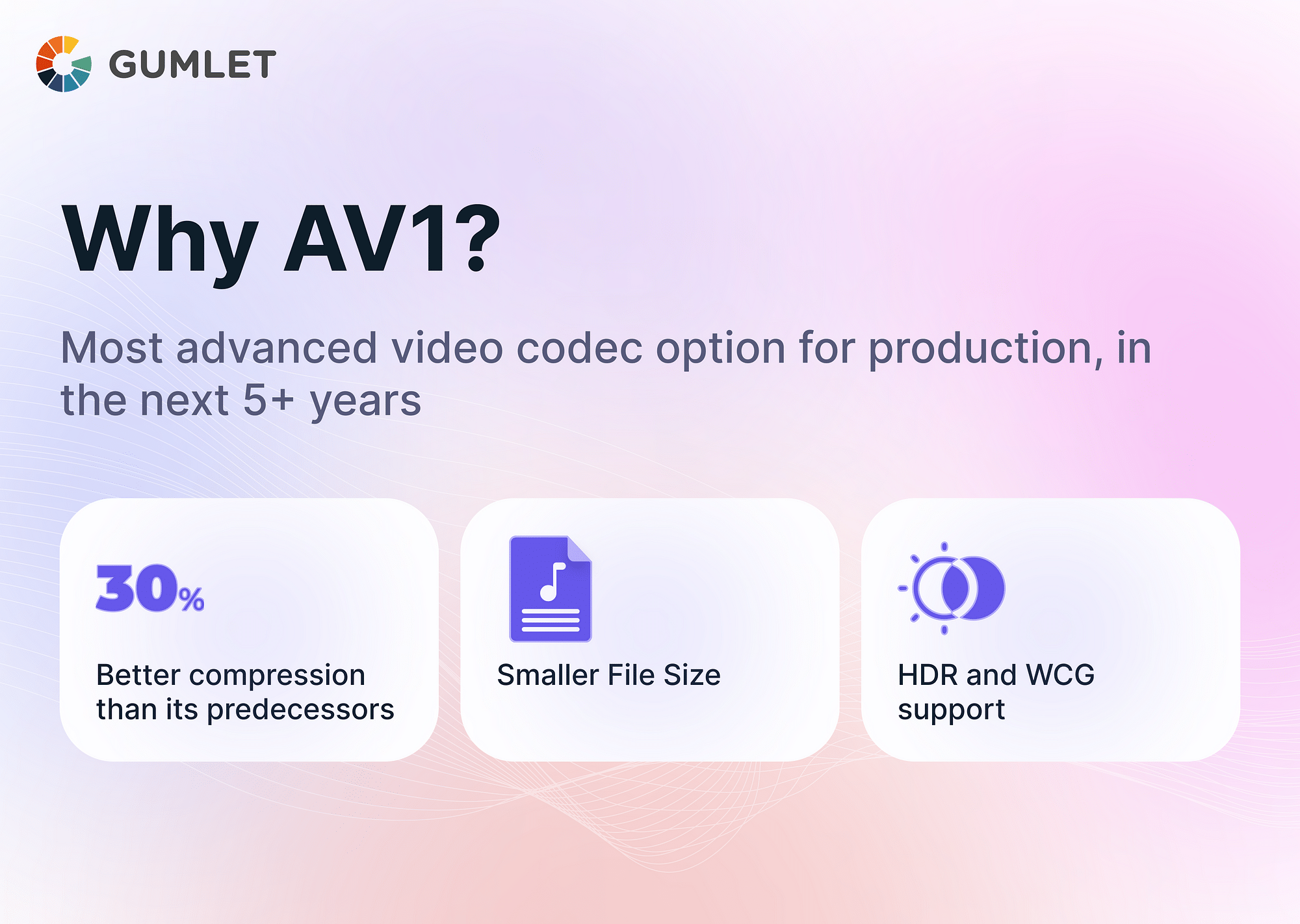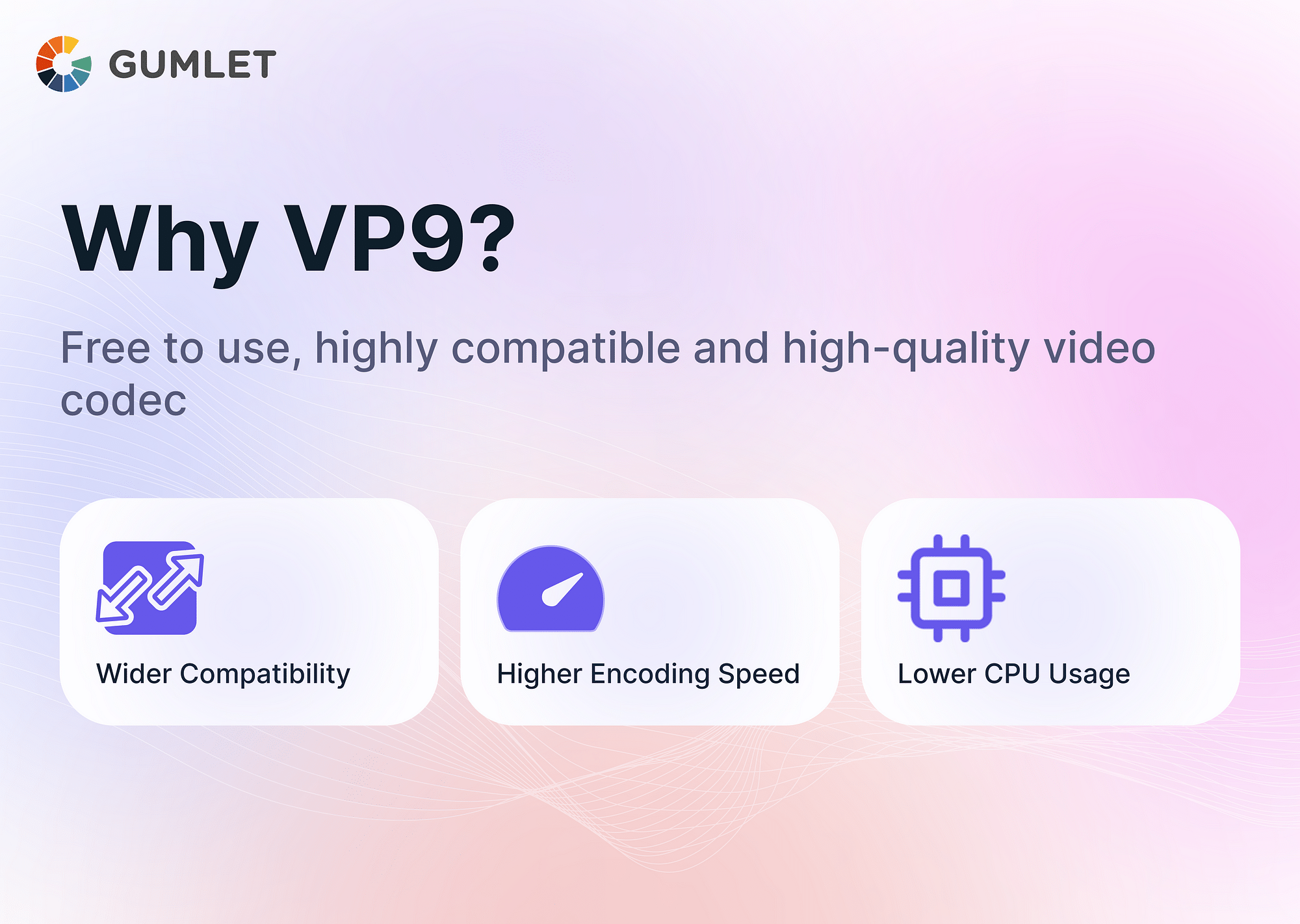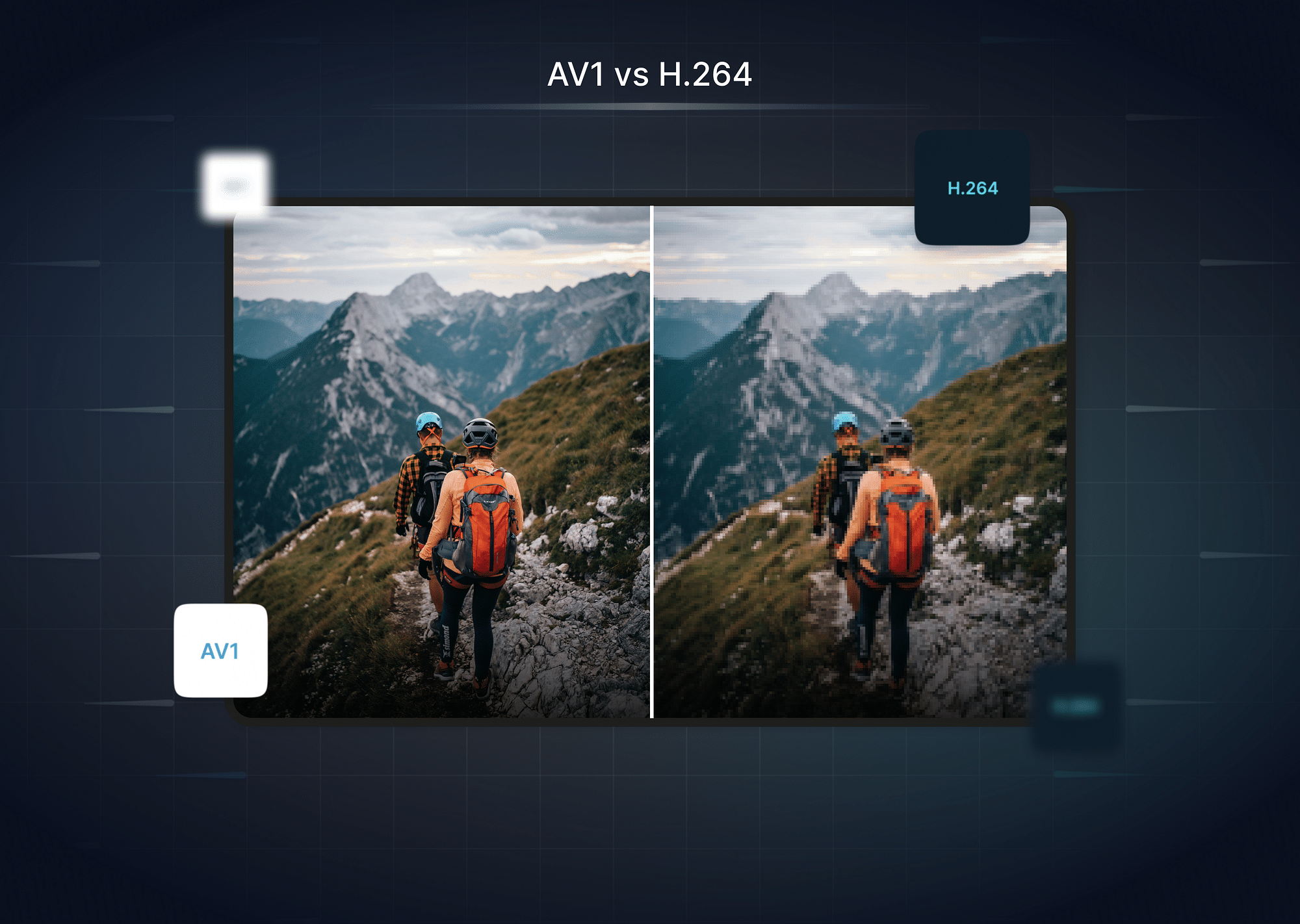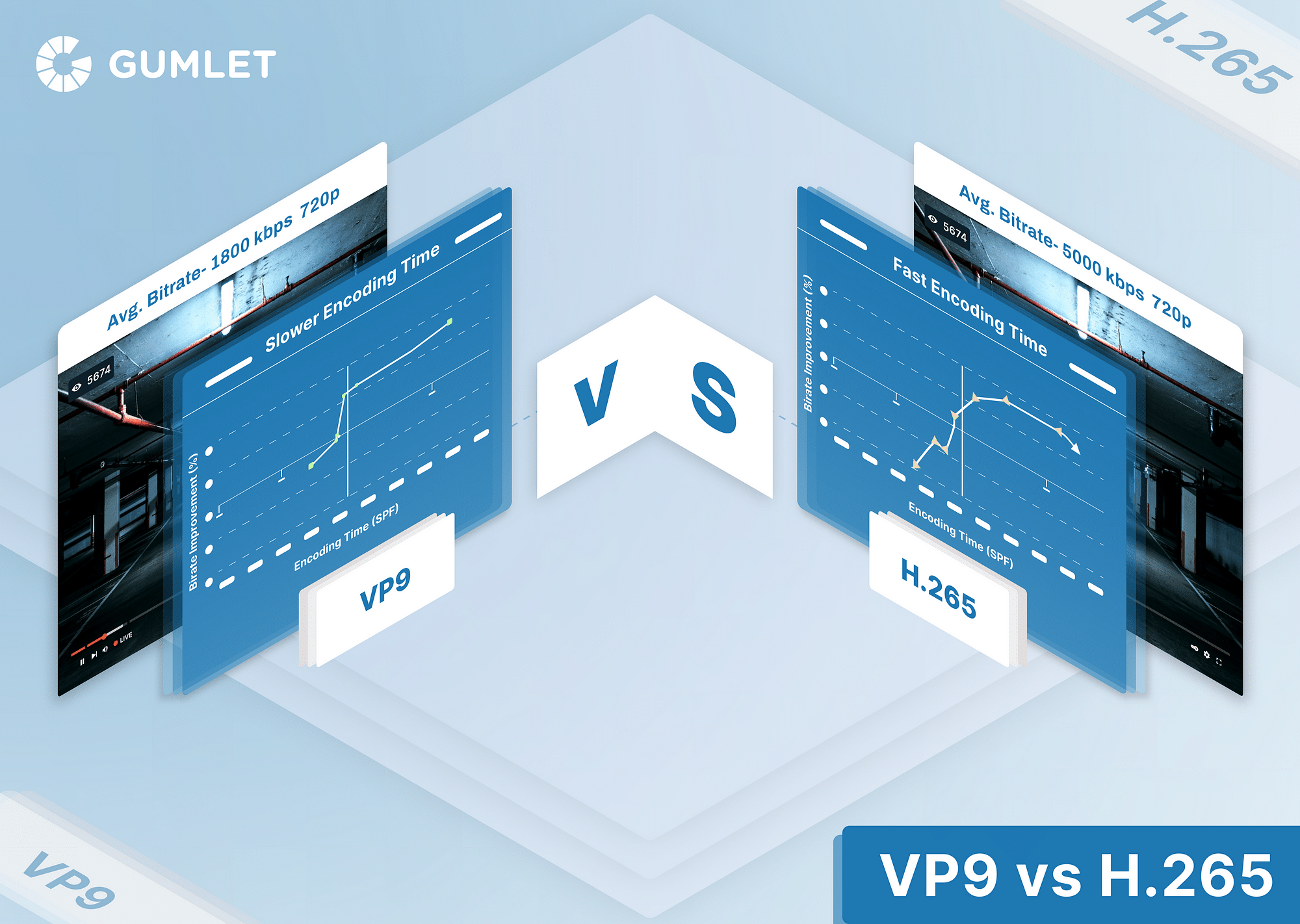AV1 and VP9 codecs are two of the most popular, open-source, and royalty-free codecs in the market today, each claiming to offer superior video compression and quality. However, choosing between these two codecs can be challenging, especially for non-technical users.
In this blog, we will dive deep into the AV1 vs. VP9 debate, explore their features, and provide a detailed comparison to help you decide on which codec to choose for your video needs.
What is AV1 Codec?
AOMedia Video 1, or AV1, is a relatively new open-source, royalty-free video codec. As the name suggests, the algorithm was developed by the AOMedia Consortium as a solution for improved video transmissions on the Internet.
The AV1 codec was designed as the successor of VP9, offering many benefits and improvements over its predecessor.
What is VP9 Codec?
VP9 is another open-source and royalty-free video encoding algorithm that Google developed. The most popular use-case of this codec is to stream videos on the internet.
The VP9 codec offers a range of improvements over its older alternatives, primarily a bitrate reduction of 50% while retaining the same apparent visual quality.
Difference Between AV1 vs VP9
Both AV1 and VP9 video codecs are completely free to use. However, they have their own unique strengths and weaknesses.
Here's drawing a detailed comparison between the two:
| Comparison Metric | AV1 | VP9 |
|---|---|---|
| Quality | Better video quality. | Lags in terms of video quality. |
| Compression Rate | Compression rate is improved by around 30% compared to the VP9 standard. | Compression rate is lesser when compared to the newer video encoding standards. |
| Royalty-Free | Yes | Yes |
| File Size | Smaller File Size | Bigger File Size |
| Encoding Efficiency | Higher than VP9 | Lower than VP9 |
| CPU Usage | Higher CPU Usage | Lower CPU Usage |
| Compatibility | Not compatible with old hardware or traditional browsers. Used by YouTube and Netflix for streaming. |
It offers greater compatibility compared to AV1. Supported by major browsers, devices, and 2 billion+ end users. |
Here's a brief summary of what the above table highlights:
Quality
AV1 has two main advantages over VP9: its ability to deliver higher video quality at lower bitrates and its wider support for newer video technologies such as High Dynamic Range (HDR) and Wide Color Gamut (WCG). AV1 can encode video content with HDR and WCG information, resulting in more vibrant and realistic colors, while VP9 has limited support for these features. This is especially noticeable in high-resolution videos with complex visual content.
Compression Rate
AV1 is a newer codec that uses advanced techniques for compressions, such as improved motion prediction, better intra-frame coding, and advanced entropy coding. It is designed to achieve up to 30% better compression than its predecessor, VP9, but requires more processing power and longer encoding times. VP9 is a more mature codec that has existed for longer and is widely supported by many devices and platforms. It is faster and less resource-intensive than AV1, making it a good choice for streaming video content on devices with limited processing power.
Royalty-Free
Google has long established that VP9 is and will continue to remain an open-source, royalty-free video encoding standard. Thus, any VP9 video is highly accessible to all users. Similarly, AV1 is also an open, royalty-free algorithm. AV1 encoding, therefore, is also free to use.
File Size
The AV1 algorithm is highly efficient at bitrate reduction while compressing videos. It also provides smaller file sizes than VP9 while providing the same apparent output video quality.
Encoding Efficiency
The AV1 codec is more efficient than the VP9 codec, with a 25% efficiency gain compared to VP9, indicating better compression while maintaining the same level of video quality. It is an appealing option for those seeking high-quality video quality with better compression, especially for streaming services where bandwidth optimization is crucial.
CPU Usage
The compatibility options of VP9 are higher because the encoding format is less complicated and supported by old hardware and software. Therefore, the CPU usage demands of VP9 algorithms are comparatively lesser.
On the other hand, the AV1 format uses complex and latest algorithms. Therefore, their CPU usage is higher and can only be supported by the latest hardware, like the new SoCs and GPUs.
Compatibility
VP9 is currently more widely supported regarding compatibility, with over two billion users using it. It can be run on all kinds of smartphones, smart TVs, and browsers, both old and new. On the other hand, AV1 uses more complex algorithms to facilitate the compression/decompression process, causing it to lag in this category. As a result, it may not be playable on older devices and browsers

AV1 vs VP9 - Which is the Best Codec for Streaming?
Video codecs are essential for streaming high-resolution videos, as they compress them to smaller sizes without compromising quality and reduce bitrate requirements. So, which codec is better for streaming?
Technically speaking, AV1 is more suitable for online video streaming because of its excellent compressibility features, high performance, coding efficiency, and compatibility with high-resolution videos.
Let's examine this conclusion further:
- In the case of On-Demand Streaming: On-demand streaming platforms like YouTube have videos encoded in both VP9 and AV1 codecs. However, there is a slight distinction in their applications. The VP9 codec is better suited for HD/4K or VR videos, while AV1 compresses 8K UHD videos. Moreover, VP9 is restricted to Google's products like YouTube, while platforms like Netflix and Prime Video more widely adopt AV1.
- In the case of Live Streaming: Both VP9 and AV1 codecs are used for live streaming on platforms like YouTube and Twitch. While VP9 was more appropriate for this purpose because of its high compatibility, AV1 is catching up now that general hardware standards are improving.

Why is AV1 Not Widely Used?
While AV1 is seeing significant improvements and has already attracted several streaming platforms like Netflix and Prime Video, the quest to become the global codec is still ongoing. The following are the persistent issues hindering this development:
- AV1 is royalty-free and has improved compression efficiency, but its encoding speed is 3x slower than HEVC and VP9. Improvements are underway to make it more widely adopted.
- AV1 is less compatible than VP9 and other codecs, requiring hardware systems to use slow and exhausting software-based solutions.
- Users have complained that the AV1 codec is incompatible with their Windows Media Player, but the simple solution is downloading it for smooth operation. However, a lack of awareness and difficulty finding the right solutions can sway the masses away from the coding standard, which has been the case
The Future of AV1, VP9, and other Codecs
Despite AV1's limitations, its numerous advantages, including being royalty-free and more efficient compression, make it a desirable option for streaming platforms. However, its slow encoding speed and lack of compatibility with some hardware and software remain obstacles to its widespread adoption. VP9, on the other hand, is currently widely adopted by streaming platforms and major web browsers due to its excellent compatibility.
The future of video codecs will depend on how quickly hardware and software industries can catch up and support newer standards. AV1 has a promising future due to its royalty-free nature and superior compression. In the meantime, streaming platforms will use a combination of codecs such as VP9 and HEVC to ensure compatibility with a wide range of devices.
Conclusion
In conclusion, AV1 and VP9 codecs are excellent options for users requiring high-quality video compression with no licensing fees. While both codecs have their strengths and weaknesses, AV1 has the advantage of compression efficiency and future compatibility, while VP9 is more widely used and offers a stable and reliable solution. Both codecs will evolve and offer better video compression and quality in the future, but the choice depends on the user's requirements and the adaptability of the codec.
FAQs
1. Is VP9 lossy or lossless?
VP9 is a lossy video codec. This means that it reduces the size of the video file by removing redundant or less important information, which can result in some loss of quality. However, VP9 is designed to be very efficient at compression, so the quality loss is generally minimal, especially when compared to older codecs.
2. Does OBS support AV1?
Yes, OBS has recently updated its settings to support AV1. You can go to the stream setting in OBS and select AV1 to enable it in the software.
- VP8 vs VP9 vs AV1: What’s the Difference?
VP9 is a significant improvement over VP8, offering better compression efficiency and quality. However, AV1, the most recent codec, surpasses both VP8 and VP9 in terms of compression efficiency and image quality. AV1 is widely considered the state-of-the-art video codec, offering superior performance for streaming and downloading videos.
4. Does YouTube use AV1 or VP9?
Most google products like Youtube widely use VP9. In comparison, other streaming services, like Amazon, Netflix, Nvidia, etc., have adopted AV1. But you can enable the Av1 codec in YouTube settings and play videos in the playlist 4K, 5K and 8K videos with the new AV1 codec.
- Which codec has wider hardware support, AV1 or VP9?
VP9 currently has wider hardware support compared to AV1, as it has been in use longer and is supported by many existing devices. However, AV1 support is increasing as it gains traction and is integrated into newer hardware.




